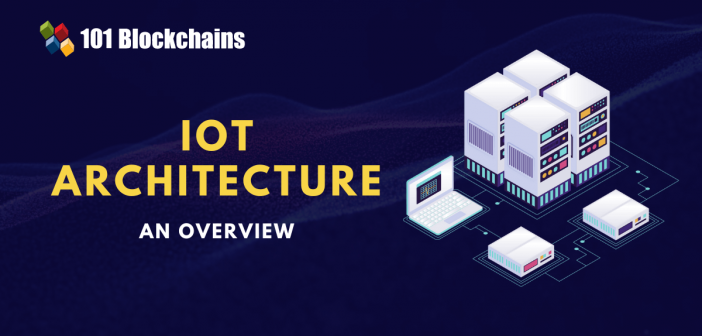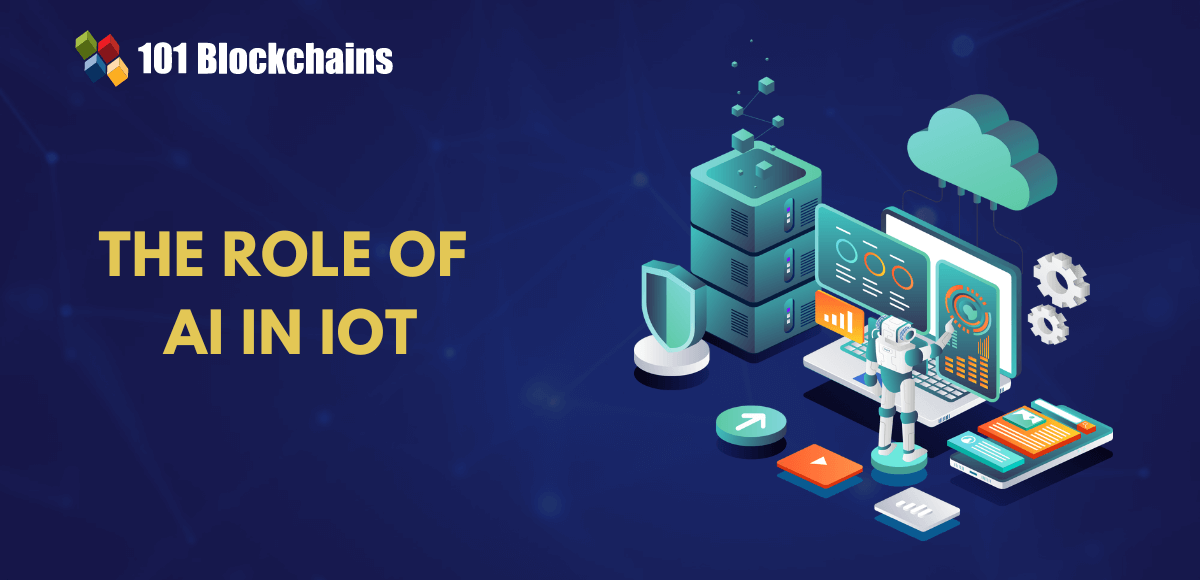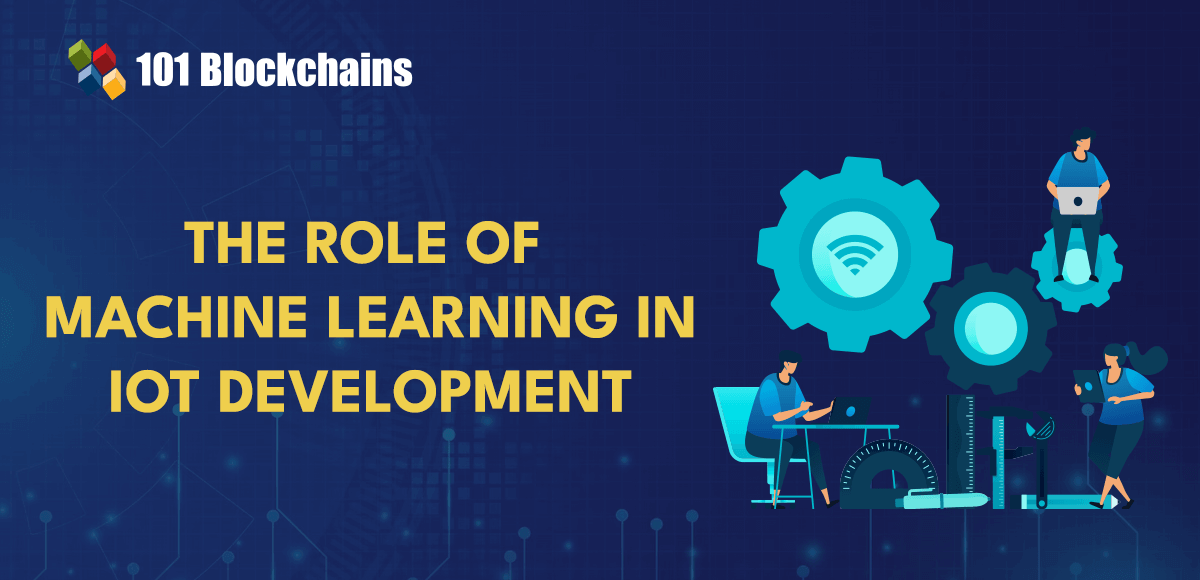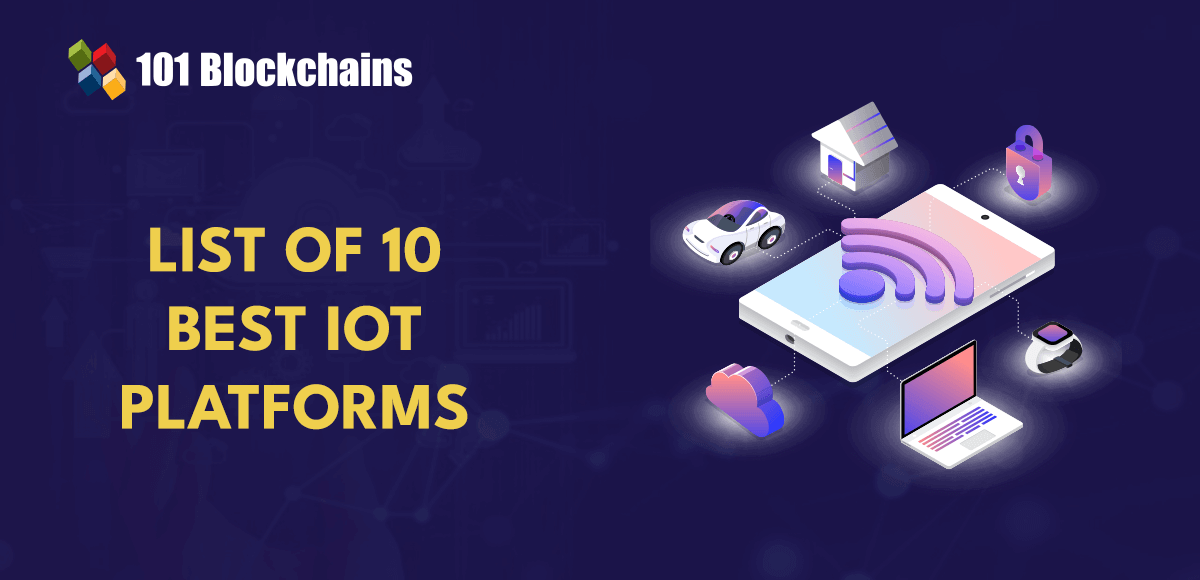The different applications of Internet of Things have been entering different spaces of our lives in multiple ways. For example, smart traffic management and smart security cameras prove the impact of IoT on the daily life of an individual. On the other hand, IoT also offers the benefits of automation for different processes and operations in industries. Therefore, the efficient design of IoT architecture for real-world solutions is a crucial priority for businesses and IoT professionals. The Internet of Things has introduced a revolutionary concept for connecting different types of “things” to the internet so that they can interact with other devices and users. The “things” in the IoT landscape could be anything ranging from a refrigerator in your home to equipment in industrial manufacturing facilities.
One of the first questions in the minds of beginners about IoT would point to how IoT achieves connectivity between devices and users. The answers to “What is the structure of IoT architecture?” could help you in learning about the effective ways to use IoT technology. A closer look at IoT fundamentals could show you that the Internet of Things is more than adding sensors to devices. IoT devices and networks create broad use cases for analytics from massive volumes of data generated by IoT devices worldwide. The following post helps you understand the basics of the architecture of the Internet of Things and how it can support IoT operations.
Definition of IoT Architecture
The first thing you need to understand the architecture of the Internet of Things is the definition of the term. In the case of IoT, architecture refers to the planned network involving devices, cloud technology and network structure, which can enable communication among IoT devices. Now, you must think about the reasons why you should learn about Internet of Things architecture.
How can your knowledge of the architecture of IoT help you? IoT technologies are capable of introducing massive benefits for businesses across different industries. Revolutionary IoT applications can help in managing devices remotely along with better efficiency, security, and accessibility. On the contrary, businesses have been hesitant to the adoption of IoT solutions due to a lack of awareness and guidance for creating robust IoT systems.
An effective and planned architecture for an IoT solution could offer significant advantages in encouraging IoT adoption. An understanding of different IoT architecture layers can help in identifying opportunities for the effective utilization of resources. Robust architectures for Internet of Things solutions can also ensure easier management of workflows alongside better business decisions based on analytical insights. Missing components in the architecture of your IoT solution could result in problems such as data leakage or failure to capitalize on the true potential of IoT.
Want to understand the fundamentals of the Internet of Things (IoT)? Enroll Now in IoT Fundamentals Course!
Layers of IoT Architecture
The complexity of IoT solution architectures can be a formidable challenge for IoT adoption. Interestingly, you can understand the basic architecture of IoT by using the different layers in the architecture for Internet of Things solutions. The four types of models which explain the architecture of Internet of Things solutions include,
- 3 layer architecture
- 4 layer architecture
- 5 layer architecture
- 7 layer architecture
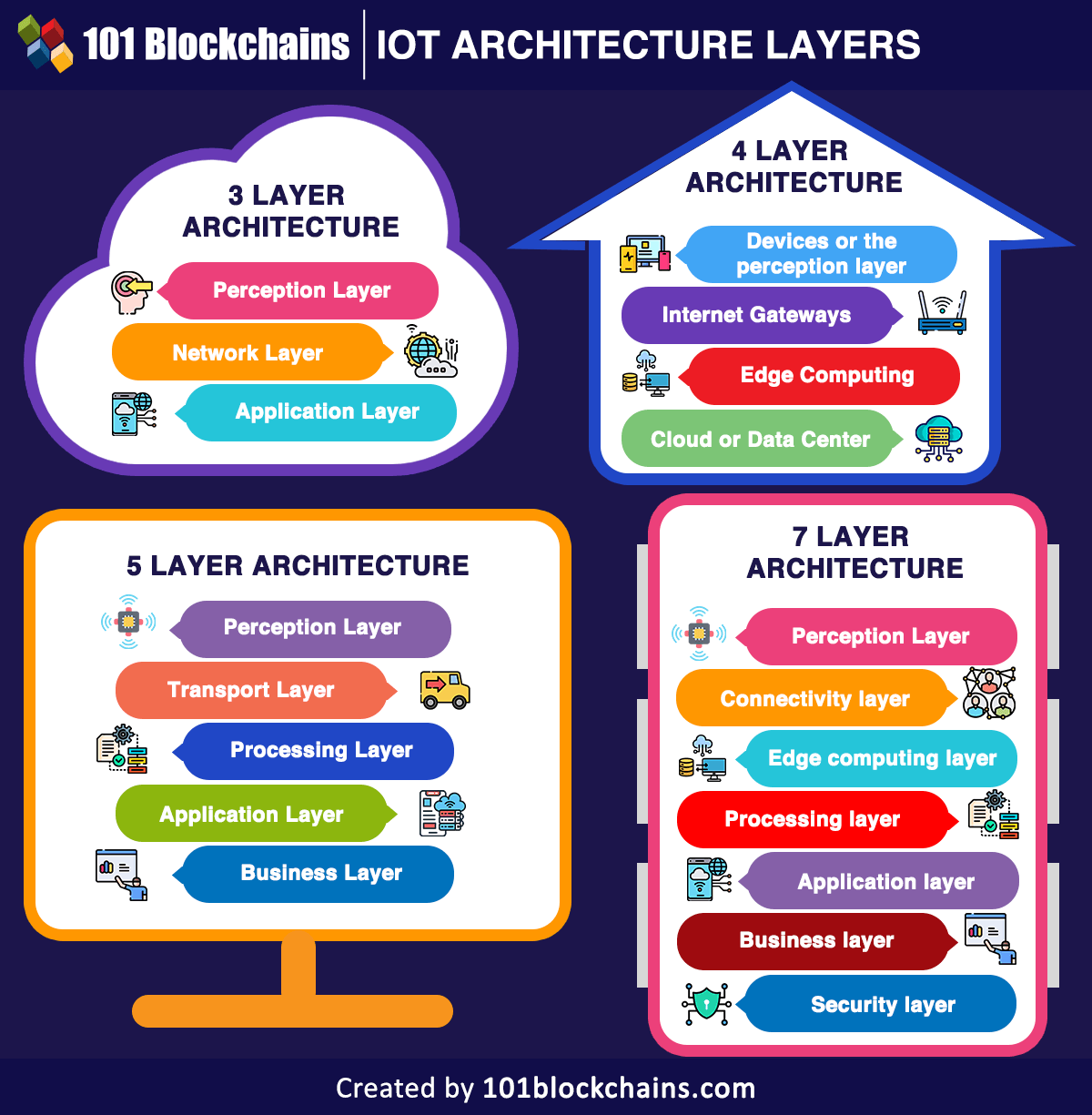
Please include attribution to staging2.101blockchains.com with this graphic. <a href='https://staging2.101blockchains.com/blockchain-infographics/'> <img src='https://staging2.101blockchains.com/wp-content/uploads/2023/03/IoT-Architecture-Layers.png' alt='IoT Architecture Layers='0' /> </a>
Some of you might wonder how many layers you can find in the architecture of an IoT solution. Is it some kind of puzzle you unravel layer by layer? No, the different models explain IoT architecture from different perspectives. For example, the 3 layer architecture offers the most basic impression of how an IoT network should look like. However, the 3-layer model could not cover other important aspects related to the operations of IoT networks.
The 5-layer architecture presents an extended high-level overview of how IoT solutions should work by improving on the 3-layer architecture. The 4 layer architecture offers a representation of the technical structure of an IoT solution with details of important components. Finally, the 7-layer architecture for the Internet of Things offers a comprehensive framework for the implementation of IoT solutions. If you want to learn about the architecture of Internet of Things solutions, you need to understand the different models of architecture layers in the Internet of Things solutions.
Want to familiarize yourself with the technology stack associated with IoT? Enroll Now in Internet Of Things (IoT) – Intermediate Level Course!
3 Layer Architecture
The difference in use cases for various industries implies that IoT solutions for two projects will have different architectures. However, the 3 layer IoT architecture presents the earliest model for describing the structure of IoT applications. Irrespective of the differences in use cases, IoT solutions have always included some consistent layers. The three-layer architecture for the Internet of Things applications has been the most common model for defining IoT application design. Here is an outline of the elements in the three-layer Internet of Things architecture.
-
Perception Layer
The perception layer in the basic architecture of IoT includes the sensors used for IoT solutions and networks. It serves as the core component for IoT functionality by offering access to data, which can be collected from different sensors on IoT-connected devices. The perception layer also includes actuators, which respond according to changes in their environment.
-
Network Layer
The network layer is another crucial component in the domain of IoT as it explains the movement of data in the IoT network. Network layer is crucial to the IoT architecture for establishing connectivity among the different devices alongside sending data to the relevant backend services.
-
Application Layer
The three-layer architecture for IoT solutions also includes the application layer. It serves as the user-facing layer of an IoT solution, such as the smartphone app for controlling IoT devices in smart homes.
Start learning Blockchain IoT with World’s first IoT (Internet Of Things) Skill Path with quality resources tailored by industry experts Now!
5 Layer Architecture
The explanation for Internet of Things architecture also revolves around the introduction of five-layer architecture. While the 3 layer IoT architecture presents an effective description of the working of IoT solutions, it does not focus on the implications of using data. Here is an overview of the layers in the 5-layer model for explaining Internet of Things architecture.
-
Perception Layer
Perception layer in the 5-layer architecture model for IoT solutions is the common link with the 3-layer architecture. It represents the physical devices in the IoT networks that “perceive” data required for processing. IoT sensors in different applications, such as health monitoring systems, autonomous vehicles, security systems, and lighting systems, provide an example of a perception layer in IoT.
-
Transport Layer
The second addition to IoT platform architecture in the 5-layer model is the transport layer. It is responsible for transferring the data collected to the edge or cloud centers for processing. The transport layer utilizes internet gateways for transferring data from the perception layer, i.e., sensors, to the processing layer.
IoT network administrators utilize Wi-Fi and cellular networks for moving data across the transport layer. In addition, BLE and Low-Power Wide-Area Networks can also serve as crucial highlights in the transport layer of IoT architectures. The design of an IoT solution could involve a blend of different transport protocols according to the use case requirements.
Curious to know how the IoT business mechanisms work? Enroll now in Internet Of Things Business Impact Course!
-
Processing Layer
The capability of IoT solutions to deliver value depends on performance in processing data collected from IoT devices. Interestingly, the 5-layer IoT architecture reflects the necessity of processing IoT data for generating relevant insights. New IoT architectures utilize artificial intelligence and machine learning to create value through the analysis of data. For example, IoT devices could not only record fluctuations in temperature but also use AI to create alerts by comparing temperatures to predefined benchmarks.
-
Application Layer
Another common layer with the 3-layer architecture, the application layer, deals with the user interface of IoT solutions. Most of the processing tasks in IoT architectures do not require human intervention. However, the answers to “What is the structure of IoT architecture?” would be incomplete without the application layer.
Human intervention is essential for informing the server regarding compliance with specific rules. Application layer helps administrators in managing IoT devices and creating rules for operations of the IoT network. In addition, the application layer also involves the design of service-level agreements for IoT systems and networks.
-
Business Layer
The 5-layer IoT architecture also includes a promising addition in the form of a business layer. It focuses on the transformation of IoT data into business intelligence, which can drive effective decision-making approaches. Most of the work of the business layer depends on reports alongside live dashboards for facilitating business intelligence. IoT data from the application layer could be refined further at the business layer with the help of other integrations.
Want to learn how you can use blockchain in the Internet of Things (IoT)? Enroll in Getting Started with Blockchain And IoT Course Now!
4 Layer Architecture
The detailed overview of the two different types of models for explaining the architecture of Internet of Things solutions provides the schematics for how IoT solutions work. Now, you would need the building blocks of IoT platform architecture to create a working IoT solution. The four-stage approach provides an explanation of the different components which make an IoT solution or a description of its structure. Here is an overview of the different layers in the four-stage architecture of Internet of Things solutions.
-
Devices
The first component in the 4-layer IoT architecture refers to the devices or the perception layer described in previous models. Devices could refer to sensors or actuators which generate data or respond to the environment. The data generated by devices is translated into a digital format for transmission to the internet gateway. With the exception of time-sensitive use cases, the data from IoT devices is transferred in a raw state to gateways.
-
Internet Gateways
The second milestone in the four-stage model of IoT architecture refers to internet gateways. The internet gateways are responsible for receiving data from different stages, followed by pre-processing before sending it to the cloud. Generally, the internet gateway could be a standalone or integrated device that can interact with sensors and transfer information to the internet.
Build your identity as a certified blockchain expert with 101 Blockchains’ Blockchain Certifications designed to provide enhanced career prospects.
-
Edge Computing
The next addition among the IoT architecture layers in the four-stage approach refers to edge computing. You can rely on transferring data to the edge of the cloud to facilitate faster routes of data processing. As a result, you can ensure faster data analysis and identify the areas which need urgent attention. The edge computing layer would focus primarily on time-sensitive operations and also involves pre-processing. The advantages of pre-processing help in limiting the amount of data sent to the cloud.
-
Cloud or Data Center
The final stage in the layers of Internet of Things architecture includes the cloud or data center. In the last stage of the IoT solution, you would have to store data for processing at a later stage. The cloud or data center encompasses the application and business layers in the basic architecture of IoT solutions.
At this layer of the four-stage approach, IoT solutions would use management software or dashboards for processing data in the cloud or data centers. The cloud or data center in the architecture of Internet of Things solutions takes care of the resource-intensive operations and deep analysis use cases.
How Can You Build an IoT Solution?
The detailed overview of different models to explain IoT architecture serve as a comprehensive impression of basic design principles for IoT. How can you incorporate the different layers of Internet of Things architecture in a real-world solution? The 7-layer architecture of IoT provides a combined representation of all the elements covered in earlier models. You can rely on the 7-layer architecture as a guide for the comprehensive design of IoT solutions. The different layers in the 7 layer model for IoT architectures include the following,
- Perception layer
- Connectivity layer
- Edge computing layer
- Processing layer
- Application layer
- Business layer
- Security layer
You can notice that the 7-layer approach includes elements from the 3-layer IoT architecture, 4-stage architecture, and 5-layer architecture for IoT solutions. However, the security layer is an additional and most important highlight of the 7-layer architecture. What is the significance of the security layer?
Majority of businesses adopting IoT solutions have to choose high-level security as a default priority. IoT networks involve the transfer of sensitive user data and device information. At the same time, a lack of security features in IoT devices can create multiple vulnerabilities for IoT networks. Therefore, the security layer is a vital component in the 7-layer architecture of IoT solutions for encouraging IoT adoption. Some of the prominent levels of security in IoT architectures include device-level, cloud-level and connection-level security.
Device-level security involves the integration of special safeguards in the firmware and hardware for IoT networks. Connection-level security for IoT focuses on the encryption of confidential data with the help of IoT application messaging protocols. Furthermore, cloud-level security emphasizes on encryption of cloud data to ensure risk mitigation.
Curious to know about learning resources for blockchain IoT? Check the detailed guide Now on What’s The Best Blockchain IoT Skill Path For Me?
Conclusion
The explanations for different types of IoT architecture models show the guidelines for designing IoT solutions. Interestingly, each model presented a distinct explanation for the architecture of Internet of Things networks. The 3 layer architecture model reflected the essential components required for operating an IoT solution. Subsequently, the 5-layer IoT architecture presented improvements over the 3-layer architecture by including elements for utilizing IoT data and extracting value for business use cases.
The four-stage approach to the Internet of Things architecture describes the technical structure with an illustration of technologies required for IoT solutions. Most important of all, the 7 layer architecture model proved the significance of security layer in IoT architectures. Learn more about the uses of IoT in real-world applications and how it revolutionizes traditional business models right now.

